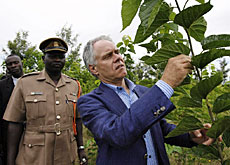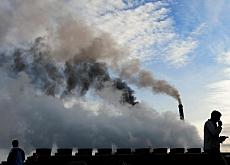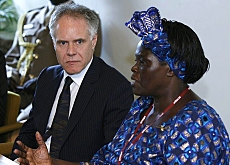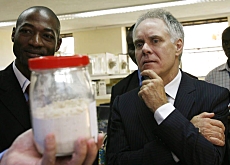Climate reality check for Swiss president

Sporting a brand-new pair of Wellington boots, Swiss President Moritz Leuenberger stepped out of his jeep to meet the farmers at Tambuzi Farm, near Mount Kenya.
“As a politician I mostly have to deal with abstract ideas, but here I can see the concrete dangers of climate change,” he told the highland farmers who depend on rainfall captured by Kenya’s second largest mountain.
Leuenberger was in Kenya last week not only to take part in the Nairobi post-Kyoto climate talks, but also to get his boots dirty to find out more about how global warming is affecting Kenyans daily lives and how Switzerland is helping them cope.
Observers called the two-week summit in the Kenyan capital “a modest step forward”. Ministers agreed to review the Kyoto Protocol in 2008 in what could be a prelude to widening the pact to include outsiders such as China and India. But environmentalists lamented the overall lack of progress.
And despite agreement on steps to aid Africa, Kenyan Environment Minister Kivutha Kibwana’s closing message at the conference was clear, “Africa’s 800 million people are on the frontline” of future climate changes.
Drought-resistant
Leuenberger’s last day of his weeklong visit to Kenya took him 200 kilometres north of Nairobi to Laikipia District in the foothills of Mount Kenya to see for himself.
Over recent years the sparse semi-arid region – like 80 per cent of Kenya – has suffered from bad droughts and highly erratic rainy seasons.
“Our main challenge is to help farmers predict seasonal weather patterns and cope with climate change,” explained Boniface Kiteme, director of the Centre for Training and Integrated Research in Arid and Semi-arid Lands (CETRAD), whose work is supported by Switzerland.
The Swiss president was shown how, with help from Swiss researchers from Bern University, local farmers at Kariunga settlement have been learning to change their habits and grow drought-resistant crops such as cassava, sorghum, millet, and also farm silk, to reduce the demand for water through improved efficiency.
“During the cabinet’s last trip to Ballenberg [historical] museum in Brienz we saw how poor Ticino farmers used to farm silk 100 years ago to secure their futures. Here something similar is going on. Our two worlds are not so different,” said an impressed Leuenberger.

More
Swiss Agency for Development and Cooperation (SDC)
Water cooperatives
At Tambuzi Farm, the Swiss president heard how nearby Mount Kenya, the water tower for the region, had lost 90 per cent of its ice over the past century.
Global warming, drastic changes in land use and a regional population explosion have put increasing pressure on scarce water resources. Those most affected by the overuse of river water are downstream users such as sheep and cattle farmers, and this situation has given rise to competition and conflicts, explained Kiteme.
Research by Swiss and Kenyan scientists aims to better understand the problems and find solutions that combine technical innovations, such as improved irrigation techniques, with social and political coordination.
One notable success story has been the formation of water user associations, which provide an effective platform for dialogue on how the essential resource should be distributed fairly between users.
“Society has to work together against climate change,” said Leuenberger.
After his five-day-long reality check, Leuenberger – who had declared that Africa would be one of the main focuses of his presidential year – seemed more convinced than ever of the need to support the continent.
“Switzerland cannot remain inactive in the face of such poverty and the extreme consequences of climate change,” he commented.
“I am convinced that bilateral assistance as well as UN support to Africa should be strengthened.”
swissinfo, Simon Bradley in Nairobi
The Swiss Agency for Development and Cooperation funds the Eastern and Southern Africa Partnership Programme (ESAPP) implemented by the Centre for Development and Environment at Bern University, together with other partners.
The programme promotes sustainable land management and regional development in six countries in eastern and southern Africa, including Kenya.
One of the ESAPP’s main partners in Kenya is the Centre for Training and Integrated Research in Arid and Semi-arid Lands (Cetrad), based in Nanyuki, Kenya, which was established via a bilateral agreement between Kenya and Switzerland in 2002.
Kenya
Area: 582,646 square kilometres
Population: 34.2 million people.
80% of the country is arid and home to 30% of the population and 50% of livestock.
Human development index: 154th.
Gross domestic product per capita: $1,445 (SFr1,753).
Swiss development aid to Africa in 2005 totalled SFr392.4 million.

In compliance with the JTI standards
More: SWI swissinfo.ch certified by the Journalism Trust Initiative




You can find an overview of ongoing debates with our journalists here . Please join us!
If you want to start a conversation about a topic raised in this article or want to report factual errors, email us at english@swissinfo.ch.